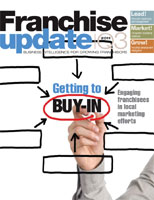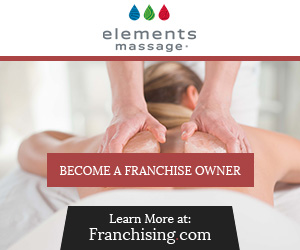Anatomy of a Start-Up: Building a Brand New Brand, Part 2
Differentiating from the start(up) in a red-hot category
In this issue's glimpse into a franchise start-up, I'll share the challenges and the victories I've encountered in attempting to differentiate our emerging EarthFruits Yogurt brand within its red-hot category and the resultant commoditization occurring within the space. I'll also make the case for augmentation of critical staff members through outsourcing for non-recurring functions, in order to get a better end result while preserving precious capital.
Evolution, not revolution
Starting with our product development, we are the first to admit that we are not rocket scientists. We aren't creating any new products or services here as frozen yogurt has been in the marketplace for decades. We are far from first in our category. For that matter we aren't even second, third, or fourth! That certainly didn't keep Burger King from taking market share from McDonald's back in the day by narrowing their focus with "flame broiling vs. frying" and "have it you way." And now it's happening again as Five Guys Burgers and Fries is evolving the category with its "better burger" concept.
Okay, back to product development. We discovered that 90 percent of our category is using the exact same product from the exact same manufacturers. So it appeared obvious that we needed to narrow our focus by having a manufacturer that could produce the yogurt equivalent of the "better burger." Our plan was to have a proprietary blend of exotic, super-healthful fruits imported from the Amazon Rainforest versus the more common shelf-stable synthetic flavors and syrups out there. In this way we could establish our role as the highest-quality provider, with the added benefit of being "champions for the preservation of the rainforest."Â
It's not what we say it is, it's what they say it is
We worked with our internal team on flavor and taste formulations and brought in a couple of suppliers from our fruit importer and our yogurt manufacturer to help us refine our recipes. We thought we had a winner. But it didn't matter what we thought, what would the public think? We contacted a local university that offered to conduct a taste panel and focus groups to help us ensure we were on point. In turn, we would pay them an honorarium of only $1,500 (talk about value)! Our focus groups loved most of our flavors, and sent us back to the drawing board on a few others that were a little too exotic for the American palate. Out of this discipline came a few important critical lessons:
- People may have good intentions when it comes to health, but not at the expense of taste. "If I want healthy, I'll go to GNC," said one participant.
- A defensive wall goes up as soon as customers feel that you are simply trying to capitalize on a "cause célèbre." You better be authentic and committed to the long haul, even when it's no longer the cool "cause du jour."
- Think global, but act local. Our focus on preserving the rainforest and helping the poorest of the poor in Brazil was appreciated, but "What about the ecology and needy here in our town?" said others. This got me thinking we should contribute 25 percent of the ad fund back to our franchisees to spend within the local market on qualified "giving back" initiatives and events.
Finding the right distribution partner
We now had high-quality, differentiated recipes in hand that we were proud of. But as a start-up, we were just too small to be able to have custom production runs with the limited quantity we needed during our proof-of-concept stage. We had to make a larger commitment to production runs, and we needed to be able to store the product and ensure we could use it before its expiration. Enter our food distributor. We contracted with Sysco. They agreed that, even though we couldn't turn our frozen products initially within their required four-month period (well within our shelf life), they were willing to roll the dice and store and deliver our product based on their high regard for the concept, belief in our management team, and our commitment to growth. It's amazing how far you can go with a vision, a good team, and passion.
ÂImpulse vs. destination
It was time to choose the site of our first location. We wanted a corporate-owned site in Utah where we are headquartered to continuously monitor service, customer wants and needs, and as a future training and R&D center. Selection of our first site was quite a wake-up call.
In order to thrive, and given the impulse nature of our high-end super-premium products, we would need to be located in an area where people live, work, and do their daily shopping, as well as where they go for entertainment and casual dining. Our type of business is typically driven by evening and weekend traffic, and further requires the density of the everyday shopping traffic or generic foot traffic to support a viable EarthFruits café. Unfortunately, many of these lessons were learned after we chose our first site. We got the visibility and traffic part right, but we learned a few very important lessons after the fact.
Specifically, we would need: high foot traffic; above-average demographics; adequate amounts of pull-up parking; ideal night-time activity generators including grocery stores, higher-end dining, theaters, performing arts centers, walking paths, etc.; and a tenant mix that supports the same types of customers who support our business model (higher-end specialty retail).
ÂOur very first market and site was lacking in many of these essential. It was going to take some world-class marketing, social media, community involvement, and PR to make up for these specific deficits. Fortunately for the franchisees who would follow in our pioneering footsteps, we developed one of the best community and site selection workbooks in the business.
Outsourcing to free up capital
My initial start-up team consisted of a director of operations, a marketer, a café manager, a vice president of franchise development, and a project manager. Every other function needed to be accomplished initially through outsourcing. "There is a growing realization in the business world that many--perhaps most--jobs can be done cheaper, more efficiently, or both by outside providers," says Michael Corbett, executive director of the Outsourcing Research Council.
"Every dollar a company does not have to spend on an internal function unrelated to its core business is another dollar it can devote to improving its competitive position in the marketplace," says Stephen McClellan, an analyst with Merrill Lynch.
For illustrative purposes, an initial professional site inspection firm and use of an outsourced company specializing in value engineering could have saved, by our calculations, in excess of $100,000 as we might have been alerted that we had inadequate power within the site and ultimately had to bring in 220-amp power from the street--which, combined with the panel, added nearly $40,000 in extra unbudgeted expense alone.
Outsourcing can free up capital to be applied to a company's mainstream strategic activities, such as marketing, new product development, and customer service. It can also provide a means for a small company to stay on the cutting edge of new technology without the kind of infrastructure commitment that normally entails. To this end, we made the decision to go with an outsourced back-end office solution (FranConnect), which included a module on construction management, in addition to a framework for financial management, franchise information management, document library, and franchise intranet system made readily available through a network of other approved IFA suppliers. Offering systems often found only in more mature franchise systems gives us a further degree of credibility.
We also made the choice to use an outsourced provider for defining and documenting our operating procedures, compiling them into an operations manual, and using this as the basis for our initial training and development.
Coming up next...
With 75 days from our soft opening, it was time to put together our franchise offering and the strategic marketing plans to achieve our goal of becoming the "Starbucks of the Frozen Yogurt Industry." Stay tuned to Franchise Update magazine for our next update on our human resources plan, and the plan we have for hiring team members who will be able to provide the highest level of customer satisfaction and loyalty in the business.
Keith Gerson is COO of Sopra Brands, whose parent company, Sopra Capital, operates the brands EarthFruits Yogurt, HouseMaster Home Inspection Services, Teriyaki Stix Japanese Grill, HomeServiceNet.com, GFEazy, lunchboxers, and Hogi Yogi. Contact him at 801-503-9214 or [email protected].
Share this Feature
Recommended Reading:
FRANCHISE TOPICS
- Multi-Unit Franchising
- Get Started in Franchising
- Franchise Growth
- Franchise Operations
- Open New Units
- Franchise Leadership
- Franchise Marketing
- Technology
- Franchise Law
- Franchise Awards
- Franchise Rankings
- Franchise Trends
- Franchise Development
- Featured Franchise Stories
FEATURED IN

Franchise Update Magazine: Issue 3, 2011








 The franchise listed above are not related to or endorsed by Franchise Update or Franchise Update Media Group. We are not engaged in, supporting, or endorsing any specific franchise, business opportunity, company or individual. No statement in this site is to be construed as a recommendation. We encourage prospective franchise buyers to perform extensive due diligence when considering a franchise opportunity.
The franchise listed above are not related to or endorsed by Franchise Update or Franchise Update Media Group. We are not engaged in, supporting, or endorsing any specific franchise, business opportunity, company or individual. No statement in this site is to be construed as a recommendation. We encourage prospective franchise buyers to perform extensive due diligence when considering a franchise opportunity.